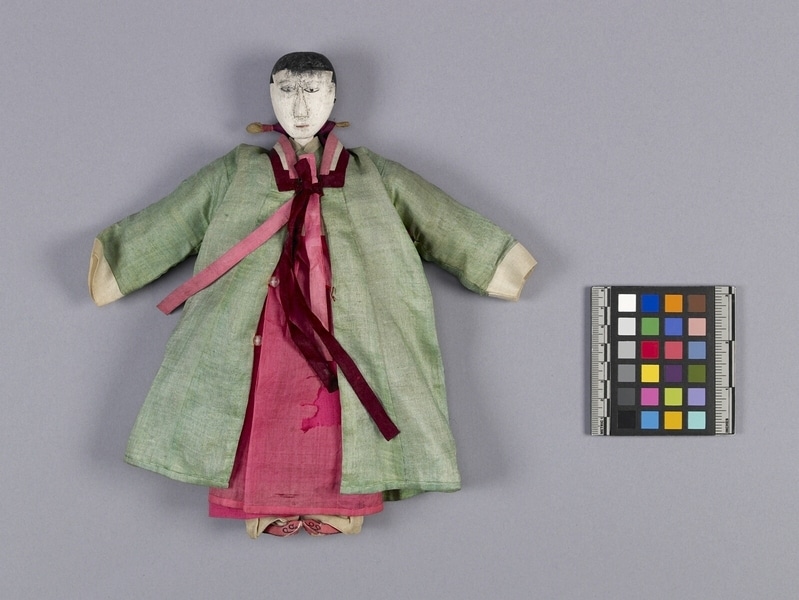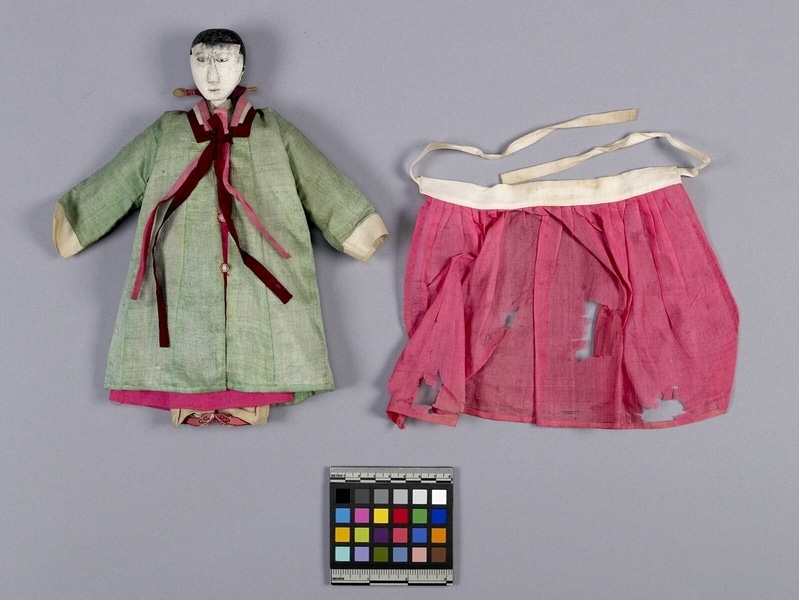Doll Item Number: N3.60 a-b from the MOA: University of British Columbia



Description
Doll depicting a female figure (a) carved out of wood with articulated shoulders and ankles. The doll's face and arms are painted white with the hair, eyes and eyebrows painted in white and the mouth painted in red. Her hair is knotted in a bun at the nape of her neck, secured with a long hairpin and covered with a purple ribbon with four coloured ornaments. Over two pairs of white under trousers with a back slit, the outer pair of which is voluminous, she wears a pleated pink skirt (b) opening at the back with a white fine cotton waistband with long ties, and short green jacket fastening with green ribbons tied in a single loop bow. Over these is a full-length green silk gored coat lined with white silk, white cotton cuffs, outer neck facings that are burgundy, white, and pink from the outside in, and burgundy panels under the arms. At the top of the centre back is pasted a white rectangle that is wider at the lower end. The sides of the coat meet at the centre, and it is tied at the top with double ties in a single loop bow, one pair pink and the other burgundy. Below the ties are three spherical buttons with loop buttonholes. She wears shoes with pointed, upturned toes covered in pink fabric and painted with a black linear and loop decoration.
History Of Use
Doll is a member of a family of dolls (see N3.61, N3.62, N3.63 and N3.64). It is likely that this set of dolls was custom-made for presentation to foreigners. They show typical Korean clothes, which were made with accurate detail of form, material, and technique for these dolls. The doll’s hairstyle is that of the late Chosun Dynasty. Before that time upper class women wore large wigs of human hair, cut off and sold by poor women as a source of income. These wigs were added to their own hair, and larger wigs were worn by women of higher status. Ornaments of coral, jade, and amber were added to the wigs. In the late Chosun Dynasty they were discouraged as being expensive and bad for women’s health. The hairstyle knotted in the back around a long hairpin is called “jjog meoli”. Hairpins worn by women of very high class were decorated with a dragon or phoenix. Those worn by more ordinary women were made of silver, jade, or sometimes gold, decorated with motifs of flowers or fruit such as peaches or pomegranates. The hair ribbon called “jiok-dawnggi,” and long coat called “jang-et”, made of green or blue silk with burgundy trim, were worn by women of the official class. “Jang-et” were worn over their shoulders, without their arms through the sleeves. When outdoors, they put the coat over their heads and drew it across to cover their faces for modesty, and so that they would not be seen by unrelated men, under Confucian influence. Women sometimes used an extra skirt “ssegae-chima” for this purpose. The coats normally had knotted frogs as fasteners. The shape of the outer edge of the outer facing changed from square to rounded during the Chosun Dynasty. In the late Chosun Dynasty, women wore very short jackets “chogori”. Those like this with only one colour were called “min-chogori”. Wide under-trousers “dan-sok-got” were worn to make the skirt appear full. The back slit in these and the inner under-trousers “sok-ba-ji” was for ease in using the toilet. Underneath women wore a breach cloth with waistband. Up to twelve layers of under-trousers were worn, which served to defend women’s virginity in case of war. Shoes with these upturned points were called “dang-hae” because they resemble a herb called “dang-cho”. They were made of satin or silk. Women wore white makeup, with black makeup around the eyes and red lip-paint. Red makeup or heavy makeup were not favoured in the late Chosun Dynasty.
Iconographic Meaning
Doll represents the mother in the family of dolls. The coat, double ties, hair ribbon and long hairpin indicate the doll was part of the yangban class, the highest social class during the late Chonson Dynasty. Purple hair ribbons symbolized that the woman was older, whereas young married women wore red, and widowhood was symbolized by black.
Item History
- Made in Korea between 1800 and 1910
- Collected between 1899 and 1939
- Owned by Marion Stephan before August 1964
- Received from Marion Stephan (Donor) during August 1964
What
- Name
- Doll
- Identification Number
- N3.60 a-b
- Type of Item
- doll
- Material
- wood, paint, silk fibre, cotton fibre, dye, paste adhesive and glass
- Manufacturing Technique
- carved, smoothed, painted, spun, woven, dyed, cut, sewn, pleated, pasted and tied
- Part A
- height 25.7 cm, width 21.6 cm, depth 4.0 cm
- Part B
- height 18.0 cm, width 25.0 cm, depth 1.0 cm
Who
- Culture
- Korean
- Previous Owner
- Marion Stephan
- Received from
- Marion Stephan (Donor)
Where
- Holding Institution
- MOA: University of British Columbia
- Made in
- Korea
When
- Creation Date
- between 1800 and 1910
- Collection Date
- between 1899 and 1939
- Ownership Date
- before August 1964
- Acquisition Date
- during August 1964
Other
- Item Classes
- textiles
- Condition
- fair
- Accession Number
- 0113/0059 a-b